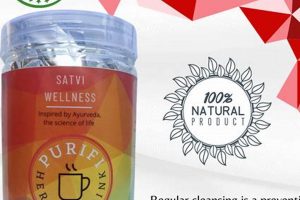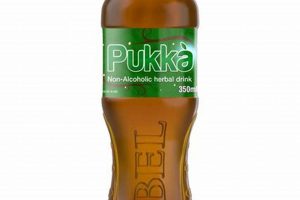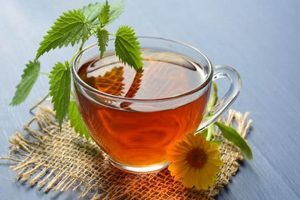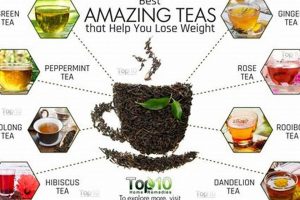Herbal teas, also known as tisanes, are infusions or decoctions made from herbs, spices, flowers, or other plant material. These beverages do not contain caffeine from Camellia sinensis, the plant that yields true teas like green, black, and oolong varieties. Instead, they offer a diverse range of flavors and potential health benefits derived from the specific botanical ingredients used.
The appeal of consuming herbal infusions stretches back centuries, with various cultures employing them for medicinal and ritualistic purposes. These preparations are often valued for their soothing properties, potential to promote relaxation, and contributions to overall well-being. The specific advantages vary depending on the plant or blend utilized.
The subsequent sections will detail commonly consumed herbal infusions, outlining their flavor profiles, potential health benefits, and considerations for consumption. Exploration will include chamomile, peppermint, ginger, and other notable examples of these botanical beverages.
Guidance on Selecting Optimal Herbal Infusions
The following outlines important considerations to assist in identifying appropriate herbal infusions for individual needs and preferences.
Tip 1: Consider Desired Effects: Different herbal infusions offer varying potential benefits. Chamomile is often associated with relaxation, while ginger is known for digestive support. Identify specific goals when selecting an infusion.
Tip 2: Research Potential Interactions: Certain herbs may interact with medications or pre-existing health conditions. Consult with a healthcare professional before regularly consuming herbal infusions, particularly when taking prescription drugs.
Tip 3: Prioritize Quality and Source: Opt for herbal infusions from reputable suppliers that adhere to quality control standards. Look for certifications or indications of sourcing practices to ensure purity and potency.
Tip 4: Examine Ingredient Lists: Carefully review ingredient lists to identify any potential allergens or unwanted additives. Choose infusions with simple, recognizable ingredients.
Tip 5: Begin with Small Quantities: When trying a new herbal infusion, start with a small serving size to assess tolerance and potential adverse reactions. Gradual introduction minimizes the risk of discomfort.
Tip 6: Note Flavor Profiles: Herbal infusions exhibit diverse flavor profiles, ranging from floral and sweet to spicy and earthy. Sample a variety to discover preferences and identify infusions that are enjoyable to consume regularly.
Tip 7: Storage Considerations: Proper storage is essential for preserving the quality and potency of herbal infusions. Store loose-leaf herbs and teabags in airtight containers, away from direct sunlight and moisture.
Selecting beneficial herbal infusions involves considering individual needs, researching potential interactions, and prioritizing quality and ingredient transparency. Informed selection promotes a positive and safe experience.
The subsequent section provides a final summary.
1. Flavor profile
The flavor profile is a primary determinant in selecting herbal infusions. The subjective experience of taste influences both the enjoyment and consistent consumption of these beverages. Individual preferences guide choices and impact the potential to realize the benefits associated with specific herbs.
- Impact on Adherence
A palatable flavor profile enhances the likelihood of regular consumption. Unpleasant tastes may deter individuals from continuing to drink an herbal infusion, negating any potential health benefits. The selection process should prioritize flavor profiles that align with personal preferences to encourage consistent intake.
- Influence on Perceived Benefits
The perceived effectiveness of an herbal infusion can be intertwined with its flavor. Positive taste experiences may lead individuals to associate the beverage with positive outcomes, such as relaxation or improved digestion, even if the effects are partially psychological. Flavor can act as a placebo trigger.
- Masking of Undesirable Compounds
Certain herbs possess inherent bitter or astringent qualities. Formulating herbal infusions with complementary ingredients can mask these unfavorable tastes, making the beverage more palatable. Flavor blending techniques can enhance the overall drinking experience and improve compliance.
- Cultural and Regional Variations
Flavor preferences vary across cultures and regions. Certain herbal infusions are deeply ingrained in specific culinary traditions, reflecting regional taste preferences and the availability of local herbs. Understanding these cultural nuances is crucial when recommending or selecting herbal infusions for diverse populations.
The flavor profile acts as a critical bridge between the inherent properties of herbal ingredients and the consumer’s willingness to incorporate them into their routine. Prioritizing pleasant and palatable flavors is essential in promoting the widespread adoption of herbal infusions and maximizing their potential benefits.
2. Targeted effects
The selection of botanical infusions is intrinsically linked to the desired physiological outcome. The term targeted effects refers to the specific health-related benefits sought by the consumer, which directly influences the choice of herbal ingredients. For example, if an individual aims to alleviate insomnia, infusions containing chamomile or valerian root are often considered, as these have demonstrated sedative properties. Conversely, for improving alertness, infusions including rosemary or peppermint may be selected, due to their purported stimulating effects. This cause-and-effect relationship highlights the importance of identifying targeted effects before choosing an infusion.
The efficacy of botanical infusions in achieving targeted effects hinges on various factors, including the concentration of active compounds, preparation methods, and individual physiology. For instance, brewing time and water temperature can impact the extraction of beneficial compounds from the herb, thereby influencing the intensity of its effect. Furthermore, individual factors such as metabolism, existing health conditions, and concurrent medication use can alter the response to specific herbs. A comprehensive understanding of these variables is crucial for maximizing the therapeutic potential of herbal infusions while minimizing the risk of adverse reactions. The selection process, therefore, should consider both the desired outcome and the biological mechanisms through which the infusion may achieve that effect.
In summary, targeted effects represent a crucial component in the selection and utilization of botanical infusions. The choice of specific herbs should be based on a clear understanding of their potential therapeutic properties and how these align with individual health goals. While botanical infusions offer a range of potential benefits, their effectiveness is subject to various individual and contextual factors. The appropriate selection and preparation, informed by an awareness of targeted effects, serves to optimize the potential benefits and minimize potential risks associated with their consumption.
3. Ingredient purity
Ingredient purity is a critical factor in determining the quality and potential health benefits of herbal infusions. The presence of contaminants or adulterants can negate the intended effects and, in some cases, pose health risks. Therefore, discerning the purity of herbal ingredients is essential when selecting the optimal herbal teas to drink.
- Source and Cultivation Practices
The origin and cultivation methods of herbs significantly impact their purity. Herbs grown in contaminated soil may absorb heavy metals or pesticides, which subsequently leach into the infusion. Opting for herbs sourced from reputable suppliers that adhere to organic or sustainable farming practices reduces the risk of contamination. Certification from recognized organizations offers assurance of adherence to stringent quality standards.
- Processing and Handling
Post-harvest processing and handling procedures influence ingredient purity. Improper drying, storage, or transportation can lead to mold growth, microbial contamination, or degradation of active compounds. Manufacturers employing controlled processing environments and rigorous quality control measures minimize these risks. Transparent sourcing and processing information allows consumers to make informed choices.
- Adulteration and Substitution
Adulteration, the intentional substitution of genuine herbs with cheaper or inferior materials, poses a significant threat to ingredient purity. Unscrupulous suppliers may dilute herbal products with fillers or substitute closely related but less potent species. Independent laboratory testing and authentication methods can detect adulteration. Consumers should exercise caution when purchasing from unverified sources or those offering unusually low prices.
- Contaminant Testing and Certification
Comprehensive testing for contaminants, including heavy metals, pesticides, and microbial pathogens, is crucial for ensuring ingredient purity. Reputable manufacturers subject their herbal products to rigorous laboratory analysis and provide certificates of analysis (COAs) documenting the results. These COAs offer transparency and verifiable evidence of product safety and quality.
In conclusion, ingredient purity serves as a cornerstone of quality herbal infusions. Selection of herbs from trusted sources, awareness of processing practices, vigilance against adulteration, and access to contaminant testing data collectively contribute to a higher probability of enjoying a safe and beneficial herbal beverage.
4. Potential Interactions
The selection of beneficial herbal infusions necessitates careful consideration of potential interactions with medications, supplements, and pre-existing health conditions. Failure to account for these interactions can lead to adverse effects, diminished therapeutic efficacy, or exacerbated health issues. The relationship between potential interactions and the choice of herbal infusions is therefore a critical determinant of safety and effectiveness. For example, St. John’s Wort, frequently used to alleviate symptoms of depression, can interact with numerous prescription medications, including antidepressants, oral contraceptives, and blood thinners. This interaction may reduce the effectiveness of these medications or increase the risk of side effects. Similarly, ginger, often consumed for its anti-inflammatory properties, can potentiate the effects of blood-thinning medications, increasing the risk of bleeding. These examples illustrate the importance of understanding potential interactions before incorporating herbal infusions into a health regimen.
A comprehensive evaluation of potential interactions requires thorough research and consultation with healthcare professionals. Individuals taking prescription medications, those with chronic health conditions, or pregnant or breastfeeding women should exercise particular caution when considering herbal infusions. Resources such as pharmacopoeias, databases of herbal-drug interactions, and the expertise of pharmacists and physicians can provide valuable information. Healthcare providers can assess an individual’s medical history, medication list, and health status to identify potential risks and recommend safe and appropriate herbal infusions. The practical significance of this understanding lies in preventing adverse events and optimizing the therapeutic potential of both herbal and conventional treatments. Informed decision-making ensures that herbal infusions are used safely and effectively as complementary therapies.
In summary, consideration of potential interactions forms an essential component of selecting beneficial herbal infusions. Neglecting this aspect can lead to adverse health outcomes, undermining the intended therapeutic benefits. Through careful research, consultation with healthcare professionals, and informed decision-making, individuals can mitigate the risks associated with herbal-drug interactions and ensure the safe and effective use of herbal infusions as part of a holistic approach to health and well-being.
5. Individual tolerance
Individual tolerance represents a pivotal factor in determining suitability of herbal infusions. Physiological responses to herbal constituents vary substantially among individuals, impacting both perceived benefits and potential adverse reactions. Therefore, consideration of individual tolerance is critical for informed selection of appropriate infusions.
- Variability in Metabolic Processes
Metabolic rates and enzymatic activity levels exhibit significant inter-individual differences. These variations influence the absorption, distribution, metabolism, and excretion of bioactive compounds present in herbal infusions. Individuals with altered metabolic capacities may experience amplified or diminished effects compared to the general population. For example, slow metabolizers of caffeine-containing herbs may experience prolonged stimulation, while rapid metabolizers may perceive minimal effects. This variability underscores the necessity for careful initial assessment of individual responses.
- Sensitivity to Bioactive Compounds
Individual sensitivity to specific plant constituents dictates the magnitude of response to herbal infusions. Allergic reactions or sensitivities to specific herbs can manifest as mild symptoms such as skin irritation or digestive upset, or, in severe cases, as anaphylaxis. Pre-existing sensitivities should be identified prior to consumption. Furthermore, individuals may exhibit varying degrees of sensitivity to non-allergenic compounds, resulting in different thresholds for desired or undesired effects. Gradual introduction of new infusions facilitates the assessment of individual sensitivity levels.
- Influence of Gut Microbiome
The composition and function of the gut microbiome play a role in the biotransformation of herbal compounds. Certain bacteria metabolize plant constituents into more or less active metabolites, thereby influencing their bioavailability and physiological effects. Individuals with distinct gut microbiome profiles may exhibit differential responses to the same herbal infusion. Ongoing research explores the interactions between gut microbiota and herbal constituents to elucidate mechanisms underlying these variations.
- Concurrent Health Conditions and Medications
Pre-existing health conditions and concurrent medication use can alter individual tolerance to herbal infusions. Certain conditions, such as liver or kidney disease, may impair the body’s ability to process herbal constituents, leading to increased risk of adverse effects. Similarly, interactions between herbal compounds and prescription medications can affect drug metabolism or pharmacodynamics, resulting in diminished therapeutic efficacy or increased toxicity. A thorough review of medical history and medication lists is imperative for identifying potential contraindications and adjusting dosage accordingly.
The selection of appropriate herbal infusions necessitates a nuanced understanding of individual tolerance. Physiological variations, sensitivities, microbiome composition, and concurrent health conditions each contribute to the complex interplay between an individual and the bioactive compounds present in herbal beverages. Careful consideration of these factors, coupled with gradual introduction and monitoring of responses, facilitates informed decision-making and maximizes the potential for safe and beneficial utilization.
Frequently Asked Questions
The following addresses commonly raised queries regarding the selection and consumption of herbal infusions, providing clarification on essential aspects.
Question 1: What constitutes an herbal infusion, distinguishing it from true tea?
Herbal infusions, also known as tisanes, are beverages prepared from herbs, spices, flowers, or other plant materials, excluding the leaves of Camellia sinensis (tea plant). True teas, such as green, black, and oolong, are exclusively derived from Camellia sinensis leaves. The absence of Camellia sinensis in herbal infusions signifies the absence of caffeine derived from that source.
Question 2: Are herbal infusions universally safe for consumption?
While generally considered safe, some herbal infusions may interact with medications or pre-existing health conditions. Certain herbs possess potent pharmacological properties, necessitating careful consideration of potential contraindications. Consulting with a healthcare professional is advisable, particularly for individuals with chronic ailments or those taking prescription medications.
Question 3: How does the origin of herbs impact the quality of the resulting infusion?
The source and cultivation practices significantly influence the quality and purity of herbs. Herbs cultivated in contaminated soils may accumulate heavy metals or pesticides, which can then leach into the infusion. Opting for herbs sourced from reputable suppliers employing sustainable farming practices mitigates the risk of contamination and ensures a higher quality product.
Question 4: What role does brewing time play in extracting beneficial compounds from herbs?
Brewing time influences the concentration of bioactive compounds extracted from herbs. Insufficient brewing may result in a weak infusion with limited therapeutic potential, while excessive brewing can lead to bitter or undesirable flavors. Adhering to recommended brewing times for specific herbs optimizes the extraction of beneficial compounds while minimizing undesirable characteristics.
Question 5: Can herbal infusions replace conventional medical treatments?
Herbal infusions should not be considered replacements for conventional medical treatments. While certain herbs possess potential therapeutic properties, they should be regarded as complementary therapies rather than primary interventions. Individuals experiencing health concerns should seek guidance from qualified healthcare professionals and adhere to prescribed treatment plans.
Question 6: What factors contribute to the shelf life and storage requirements of herbal infusions?
Exposure to light, air, moisture, and heat degrades the quality of herbal infusions. Storing loose-leaf herbs and teabags in airtight containers, away from direct sunlight and temperature fluctuations, preserves their potency and flavor. Properly stored herbal infusions can maintain their quality for extended periods.
The information provided addresses common inquiries concerning herbal infusions. Further research and consultation with healthcare professionals are recommended for specific health-related concerns.
The subsequent sections will provide the conclusion.
Determining Optimal Herbal Infusions
The exploration of “what are the best herbal teas to drink” has highlighted the multifactorial nature of selection. Flavor profile, targeted effects, ingredient purity, potential interactions, and individual tolerance are all critical determinants. Informed decisions require careful evaluation of these parameters to ensure a beneficial and safe consumption experience. The information presented serves as a framework for responsible selection, emphasizing the importance of individual needs and evidence-based considerations.
The responsible incorporation of herbal infusions into one’s lifestyle necessitates ongoing diligence. Continued research into herbal properties and interactions remains crucial for optimizing health outcomes. Individuals are encouraged to consult with healthcare professionals to personalize their approach, ensuring that herbal infusions complement, rather than compromise, overall well-being. Further investigation and critical evaluation are essential for unlocking the full potential of herbal infusions.







